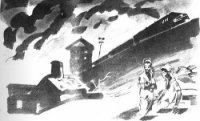Operation Nemesis: The Assassination Plot that Avenged the Armenian Genocide - Bogosian Eric (мир книг .txt) 📗
As Tehlirian stepped past Talat, the larger man adjusted his stride, slowing just slightly. The young soldier drew his pistol from his waistband, raised it to the nape of Talat’s broad neck, and squeezed the trigger. The victim probably never heard the gun fire. The bullet cleaved Talat’s spinal cord, entered the base of his skull, traversed his brain, and exited his temple just above his left eye. The shock set off a massive coronary, and the large man shuddered. Then, according to Tehlirian, “he fell on his face with a sound like a branch sawed off a tree.” A woman a few feet ahead of them on the sidewalk screamed and fainted as a single thought popped into Tehlirian’s mind: “So effortless!”
Tehlirian, whose sole raison d’etre was to end the life of the man now lying on the ground before him, immediately understood that another bullet wouldn’t be needed. Transfixed, the twenty-five-year-old Armenian refugee stood over the corpse, the pistol still clutched in his hand, as “the black thick blood flowed like kerosene out of a broken container.” The killer then dipped the toe of his shoe into the pool of blood as shouting rose up all around him: “Someone has been murdered! Grab him!” Tehlirian broke out of his trance, reflex took over, and he ran, completely forgetting his handler’s explicit instructions to stay put after the killing. “I passed by them, no one tried to stop me.” Tehlirian sprinted twenty or thirty steps, then veered into the Fasanenstrasse.
The crowd, at first reluctant to chase a violent, perhaps deranged killer, caught up with the young man and surrounded him. Someone grabbed his shoulder. Another smacked him on the back of the head. More punches and slaps. People in the crowd were attacking Tehlirian because they mistakenly believed he had gunned down a famous German general. As he was being beaten, Tehlirian felt something hard and sharp tearing at his face. Later he would realize that someone had been hitting him with a key ring full of jagged keys. The blood dripped down onto his shirt. A man interceded and hauled him off to the local police outpost by the Tiergarten gate. Tehlirian shouted to the crowd, “What you want? I am Armenian, he, Turkish. What is it to you?”3
The police hauled the bleeding young man back to the scene of the crime. “Blood was flowing from my head. Other policemen arrived. They turned me toward Hardenberg. The monster had fallen in the same position on the sidewalk. The police, the crowd, at a certain distance, surrounded all sides. We passed on.”4 The crowd surged, still struggling to lay hands on the killer. A paddy wagon rolled up and Tehlirian was shoved into the back. Fifteen minutes later he was in his cell at the Charlottenburg police station.
A trial followed a little over two months later. Stunningly, Tehlirian was acquitted. In occupied Constantinople a few weeks after that, the Muslim Azeri leader Khan Javanshir was gunned down outside the Pera Palace Hotel by another Armenian. That assassin, Misak Torlakian, would also be set free after a two-month trial. In December, Said Halim Pasha, former Young Turk Grand Vizier of the Ottoman Empire, was shot dead as he was returning to his home only blocks away from the Borghese Gardens in Rome. This assassin would also evade arrest despite a massive manhunt.
The following spring in Berlin, Said Halim’s killer, Arshavir Shiragian, teamed up with Aram Yerganian to assassinate both Dr. Behaeddin Shakir, former head of the organization that oversaw the genocide of Armenians in Turkey, and Djemal Azmi, the notorious former governor-general of Trebizond. Neither Shiragian nor Yerganian was caught. Finally, in July 1922, Djemal Pasha, one of the key members of the Young Turk government, was slain by Stepan Dzaghigian in Tiflis, Georgia. Dzaghigian was arrested by the Cheka, the Soviet secret police, and sent to Siberia, where he would remain until his death.
These assassinations and at least four others were a response to the genocide of the Armenians in the Ottoman Empire during World War I. As the war wound down, it appeared that those Turks responsible for the massive destruction of the Christian civilian population would face judgment.5 Trials were held in Constantinople, but by that time the central leaders had already slipped out of Turkey and had found safe harbor in Berlin, Rome, Tiflis, and Moscow. President Woodrow Wilson proposed a protective “mandate” for the Armenian provinces of Turkey, providing a homeland to which survivors might return. The mandate never materialized. Instead, Turkish nationalists under General Mustapha Kemal successfully pushed back forces seeking to occupy Turkish territory. By 1922, any thoughts of reparations for the Armenians, an Armenian homeland, or even a right of return had been extinguished as the Soviets moved in to claim possession of the short-lived Republic of Armenia, the tiny sliver of territory in the Caucasus to which hundreds of thousands of refugees had fled.
Operation Nemesis was an unprecedented conspiracy designed to avenge an unprecedented modern genocide. With little training, resources, or experience in intelligence operations, this humble collection of businessmen, intellectuals, diplomats, and former soldiers virtually eradicated an entire former government. As a group, they complemented one another: the quiet, steadfast members collaborated with the romantic visionaries; the impetuous spurred on the cautious. Together they formed an international team, understaffed and underfinanced, at a time when communication was by cable and all travel by rail or steamship. This thin network spread out across Europe and the Near East before systematically and effectively dispatching its targets. In the end, “Operation Nemesis” would satisfy its ambitions while having repercussions far beyond its need for revenge. Then, as suddenly as they appeared, this small cadre of businessmen, editors, and veterans faded into the background of history, almost forgotten. This is their story.
PART I
CHAPTER ONE The Rise of Empire
Ne mutlu Turkum diyene! [Happy is the man who can say, “I am a Turk!”]
—Kemal Ataturk
I am Armenian, he, Turkish. What is it to you?
—Soghomon Tehlirian
The Christian Armenians and the Muslim Ottomans claim rich and complex histories. The Armenians flourished in Asia Minor as early as the dawn of recorded history. In fact, an Armenian king established the first Christian state in AD 301, while the ancestors of the Ottoman Turks invaded the same region about seven hundred years later. By the seventeenth century, the Muslim Ottoman Empire had conquered and absorbed territory extending from Europe to Persia, including the ancient Armenian homeland. At their peak, the Ottomans displayed a cultural and scientific sophistication equal to the greatest premodern civilizations.
It is not an exaggeration to say that both peoples, the Muslim and Christian subjects of the sultans, shared a civilization for centuries. There is no greater demonstration of this fact than the awe-inspiring mosques of Istanbul, requisitioned by royalty and designed by an Armenian, Mimar Sinan. In these mosques are made manifest the grandeur of the Ottomans and the aesthetic perfection that Sinan envisioned. Neither could exist without the other.




